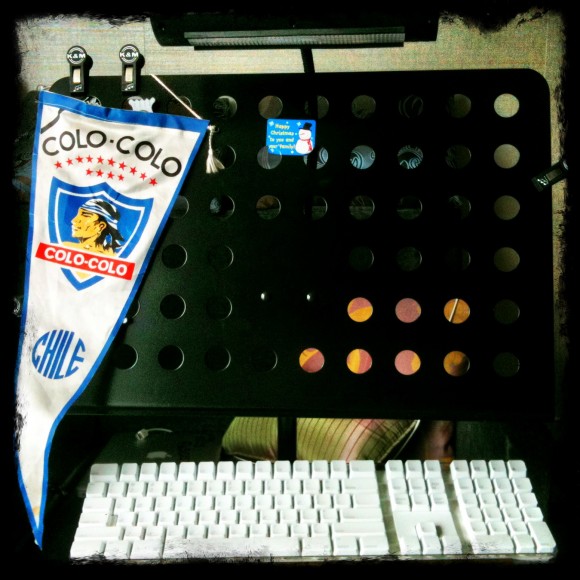Anchoring A Recording Studio Part 2
Today I packed up my music stand. This is a big step in closing down my studio. Thursday morning the removalists will come in to take most of my music gear away. I won’t be recording any more music in Hong Kong. A few months back I wrote a post about anchoring a recording studio. […]
Today I packed up my music stand. This is a big step in closing down my studio. Thursday morning the removalists will come in to take most of my music gear away. I won’t be recording any more music in Hong Kong.
A few months back I wrote a post about anchoring a recording studio. I was trying to articulate some thoughts on what might be the most important pieces of gear in my new studio.
What I didn’t realise at the time is that my humble music stand is really the anchor, or heart of my current studio. The wireless keyboard is there to control the music software. The light is there to allow me to record (& practice in the dark). The banner (of my favourite Chilean football team) and sticker (care of my daughter) are humble reminders of who I am and where I come from.
And, of course, a music stand holds music, sheet music. Those pieces of paper with songs, ideas, arrangments, solos and chord progressions are and always have been at the core of my music progress.
When it comes to designing a new studio, it might make sense to start with the music stand, because from there comes my location, as a guitarist, while playing. That then dictates the location of the amplifiers, the microphones and the like.
In thinking about the new studio I’ve changed my mind about installing a recording console. I mentioned the Allen and Heath GS-R24M and, as it turns out, that will be my first major purchase for the new studio.
My idea, of a collection of high end 500 series preamps, a top end Apogee Symphony AD/DA converter and a boutique summing mixer (Neve 8816) was typical of my approach to technology. It was novel, complex and aspirational.
It was also a bit misguided. I might end up having that gear in my studio one day. But, my biggest need right now is to get up and running, fast. Opting for a console gives me a simple and straightforward layout.
GS-R24M
Mac Pro
Monitors (Focal SM6 Twin6 Be and Avantone Active Mix Cubes)
Microphones and Cables
That frees up a lot of mental space to concentrate on creating a good natural sound in the new studio space. I really want to step away from the computer a bit. My music in Hong Kong has become very computer-oriented. That’s been a great experience and I’m not abandoning that (especially not the sample-driven orchestration), but I want to refocus more on the analog side of the equation.
The GS-R24 is an analogue recording desk, that also doubles up as a software controller (with motorised faders) for driving Logic Pro and it can be configured with a 32 input/output firewire AD/DA converter card. It also has two valve channels that can be used to “warm” up direct signals, or reamp software sounds. In effect, one piece of kit handles five key stages in the studio workflow.
There will be some more outboard gear. One 500 series rack will house some Radial gear for re-amping and direct recording (with the potential for some dedicated preamps in the future. I will pick up a high end outboard compressor and eq for mixing (and basic in house mastering).
But, for the first few months it will be a simple, barebones, classic kind of studio. That has me really excited. I hope to spend many hours staring at that music stand while recording new music.
Of course, I need to come up with a name for the studio. I’m thinking something tropical, evoking the history of analog recording, maybe guitar oriented. October 1st is set as the opening of the new studio (OK, I’m kind of hopeless with that sort of planning). So I dont have long to think of something. Any ideas?





